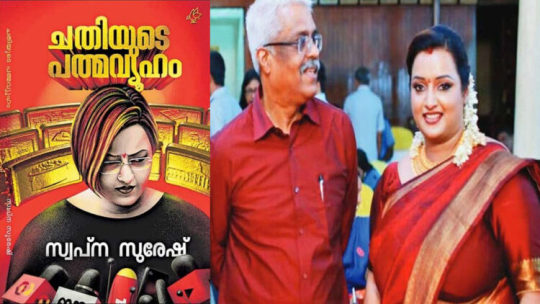#shivashankar
Explore tagged Tumblr posts
Text

🌙💙AUM Namah SHIVAYA🌙💙
87 notes
·
View notes
Text
ಉತ್ತಮ ಆಡಳಿತ ಸಪ್ತಾಹ: ಹಿರಿಯ ನಾಗರಿಕರಿಗೆ ಗುರುತಿನ ಚೀಟಿ ವಿತರಿಸಿದ ಡಿಸಿ
ಬೆಂ.ಗ್ರಾ.: ಉತ್ತಮ ಆಡಳಿತ ಸಪ್ತಾಹ-2024 ರ ಅಂಗವಾಗಿ “ಇಂದೇ ಸಕಾಲ”ದಲ್ಲಿ ಹಿರಿಯ ನಾಗರಿಕರ ಗುರುತಿನ ಚೀಟಿಗಾಗಿ ಅರ್ಜಿ ಸಲ್ಲಿಸಿದ ಕೆಲವೇ ನಿಮಿಷಗಳಲ್ಲಿ ಅನುಮೋದಿಸಿ ಜಿಲ್ಲಾಧಿಕಾರಿಗಳಿಂದ ಹಿರಿಯ ನಾಗರಿಕರಿಗೆ ಗುರುತಿನ ಚೀಟಿ ವಿತರಿಸಲಾಯಿತು. ಉತ್ತಮ ಆಡಳಿತ ಸಪ್ತಾಹ-2024 ವು 19.12.2024 ರಿಂದ 24.12.2024 ರವರೆಗೆ ನಡೆಯಲಿದೆ. “ಪ್ರಶಾಸನ್ ಗಾಂವ್ ಕಿ ಓರ��(ಗ್ರಾಮದ ಕಡೆಗೆ ಆಡಳಿತ)” ಎಂಬ ಅಭಿಯಾನದ ಮೂಲಕ ಜಿಲ್ಲೆಯಾದ್ಯಂತ ಸಾರ್ವಜನಿಕ ಕುಂದುಕೊರತೆಗಳಿಗೆ ತ್ವರಿತ ಪರಿಹಾರ ಮತ್ತು ಸೇವಾ…
0 notes
Text

🔜 ‼️ Live Zoom sessions starting this week‼️
🚀 International Virtual Advanced Nailing Course
🔅World Institute of Orthop[aedics presents 8 week long Certificate course in Advanced Nailing for Orthopaedic Surgeons
🗓️ DATES: Every Tuesday | 8:00 PM – 9:30 PM
🔗 REGISTER NOW: https://tinyurl.com/OrthoTV-VANC
👨⚕️ Course Director: Dr. B. Shivashankar (Solapur)🔥
👨🏫 FACULTY:
Dr. Sangeet Gawhale (Mumbai) 🏙️
Dr. Rajendra Chandak (Mumbai) 🏙️
Dr. Wasudeo Gadegone (Chandrapur) 🌿
Dr. Satish Mutha (Mumbai) 🏥
📚 COURSE HIGHLIGHTS:
💡 Expert-led lectures & live weekly zoom sessions
🎥 Step wise & guided Surgical video demonstrations
🩺 Case-based learning with live interaction on exclusive whatsapp group
🔧 Latest interlock nailing techniques : tips & tricks
🚑 Preventing and managing complications
🦵 Advanced treatment approaches for complex fractures
🔅 It is a Virtual Course with weekly Zoom session (every Tuesday 8 pm) & live interaction on chat group : session recordings will be available if you miss the session
🔖Certificate issued by : World Institute of Orthopaedics | OrthoTV Global Academy
📃 Discover more at: www.orthotvonline.com
🔗 Join OrthoTV: https://linktr.ee/OrthoTV
#AdvancedNailingCourse#Orthopaedics#OrthopaedicSurgeons#SurgicalEducation#VirtualLearning#OrthoTV#OrthopaedicTraining#ComplexFractures#SurgicalTechniques#InterlockNailing#OrthopaedicInnovation#FractureManagement#OrthopaedicWebinar#CaseBasedLearning#WorldInstituteOfOrthopaedics
0 notes
Text
AI model identifies certain breast tumor stages likely to progress to invasive cancer
New Post has been published on https://sunalei.org/news/ai-model-identifies-certain-breast-tumor-stages-likely-to-progress-to-invasive-cancer/
AI model identifies certain breast tumor stages likely to progress to invasive cancer

Ductal carcinoma in situ (DCIS) is a type of preinvasive tumor that sometimes progresses to a highly deadly form of breast cancer. It accounts for about 25 percent of all breast cancer diagnoses.
Because it is difficult for clinicians to determine the type and stage of DCIS, patients with DCIS are often overtreated. To address this, an interdisciplinary team of researchers from MIT and ETH Zurich developed an AI model that can identify the different stages of DCIS from a cheap and easy-to-obtain breast tissue image. Their model shows that both the state and arrangement of cells in a tissue sample are important for determining the stage of DCIS.
Because such tissue images are so easy to obtain, the researchers were able to build one of the largest datasets of its kind, which they used to train and test their model. When they compared its predictions to conclusions of a pathologist, they found clear agreement in many instances.
In the future, the model could be used as a tool to help clinicians streamline the diagnosis of simpler cases without the need for labor-intensive tests, giving them more time to evaluate cases where it is less clear if DCIS will become invasive.
“We took the first step in understanding that we should be looking at the spatial organization of cells when diagnosing DCIS, and now we have developed a technique that is scalable. From here, we really need a prospective study. Working with a hospital and getting this all the way to the clinic will be an important step forward,” says Caroline Uhler, a professor in the Department of Electrical Engineering and Computer Science (EECS) and the Institute for Data, Systems, and Society (IDSS), who is also director of the Eric and Wendy Schmidt Center at the Broad Institute of MIT and Harvard and a researcher at MIT’s Laboratory for Information and Decision Systems (LIDS).
Uhler, co-corresponding author of a paper on this research, is joined by lead author Xinyi Zhang, a graduate student in EECS and the Eric and Wendy Schmidt Center; co-corresponding author GV Shivashankar, professor of mechogenomics at ETH Zurich jointly with the Paul Scherrer Institute; and others at MIT, ETH Zurich, and the University of Palermo in Italy. The open-access research was published July 20 in Nature Communications.
Combining imaging with AI
Between 30 and 50 percent of patients with DCIS develop a highly invasive stage of cancer, but researchers don’t know the biomarkers that could tell a clinician which tumors will progress.
Researchers can use techniques like multiplexed staining or single-cell RNA sequencing to determine the stage of DCIS in tissue samples. However, these tests are too expensive to be performed widely, Shivashankar explains.
In previous work, these researchers showed that a cheap imagining technique known as chromatin staining could be as informative as the much costlier single-cell RNA sequencing.
For this research, they hypothesized that combining this single stain with a carefully designed machine-learning model could provide the same information about cancer stage as costlier techniques.
First, they created a dataset containing 560 tissue sample images from 122 patients at three different stages of disease. They used this dataset to train an AI model that learns a representation of the state of each cell in a tissue sample image, which it uses to infer the stage of a patient’s cancer.
However, not every cell is indicative of cancer, so the researchers had to aggregate them in a meaningful way.
They designed the model to create clusters of cells in similar states, identifying eight states that are important markers of DCIS. Some cell states are more indicative of invasive cancer than others. The model determines the proportion of cells in each state in a tissue sample.
Organization matters
“But in cancer, the organization of cells also changes. We found that just having the proportions of cells in every state is not enough. You also need to understand how the cells are organized,” says Shivashankar.
With this insight, they designed the model to consider proportion and arrangement of cell states, which significantly boosted its accuracy.
“The interesting thing for us was seeing how much spatial organization matters. Previous studies had shown that cells which are close to the breast duct are important. But it is also important to consider which cells are close to which other cells,” says Zhang.
When they compared the results of their model with samples evaluated by a pathologist, it had clear agreement in many instances. In cases that were not as clear-cut, the model could provide information about features in a tissue sample, like the organization of cells, that a pathologist could use in decision-making.
This versatile model could also be adapted for use in other types of cancer, or even neurodegenerative conditions, which is one area the researchers are also currently exploring.
“We have shown that, with the right AI techniques, this simple stain can be very powerful. There is still much more research to do, but we need to take the organization of cells into account in more of our studies,” Uhler says.
This research was funded, in part, by the Eric and Wendy Schmidt Center at the Broad Institute, ETH Zurich, the Paul Scherrer Institute, the Swiss National Science Foundation, the U.S. National Institutes of Health, the U.S. Office of Naval Research, the MIT Jameel Clinic for Machine Learning and Health, the MIT-IBM Watson AI Lab, and a Simons Investigator Award.
0 notes
Text
AI model identifies certain breast tumor stages likely to progress to invasive cancer
New Post has been published on https://thedigitalinsider.com/ai-model-identifies-certain-breast-tumor-stages-likely-to-progress-to-invasive-cancer/
AI model identifies certain breast tumor stages likely to progress to invasive cancer


Ductal carcinoma in situ (DCIS) is a type of preinvasive tumor that sometimes progresses to a highly deadly form of breast cancer. It accounts for about 25 percent of all breast cancer diagnoses.
Because it is difficult for clinicians to determine the type and stage of DCIS, patients with DCIS are often overtreated. To address this, an interdisciplinary team of researchers from MIT and ETH Zurich developed an AI model that can identify the different stages of DCIS from a cheap and easy-to-obtain breast tissue image. Their model shows that both the state and arrangement of cells in a tissue sample are important for determining the stage of DCIS.
Because such tissue images are so easy to obtain, the researchers were able to build one of the largest datasets of its kind, which they used to train and test their model. When they compared its predictions to conclusions of a pathologist, they found clear agreement in many instances.
In the future, the model could be used as a tool to help clinicians streamline the diagnosis of simpler cases without the need for labor-intensive tests, giving them more time to evaluate cases where it is less clear if DCIS will become invasive.
“We took the first step in understanding that we should be looking at the spatial organization of cells when diagnosing DCIS, and now we have developed a technique that is scalable. From here, we really need a prospective study. Working with a hospital and getting this all the way to the clinic will be an important step forward,” says Caroline Uhler, a professor in the Department of Electrical Engineering and Computer Science (EECS) and the Institute for Data, Systems, and Society (IDSS), who is also director of the Eric and Wendy Schmidt Center at the Broad Institute of MIT and Harvard and a researcher at MIT’s Laboratory for Information and Decision Systems (LIDS).
Uhler, co-corresponding author of a paper on this research, is joined by lead author Xinyi Zhang, a graduate student in EECS and the Eric and Wendy Schmidt Center; co-corresponding author GV Shivashankar, professor of mechogenomics at ETH Zurich jointly with the Paul Scherrer Institute; and others at MIT, ETH Zurich, and the University of Palermo in Italy. The open-access research was published July 20 in Nature Communications.
Combining imaging with AI
Between 30 and 50 percent of patients with DCIS develop a highly invasive stage of cancer, but researchers don’t know the biomarkers that could tell a clinician which tumors will progress.
Researchers can use techniques like multiplexed staining or single-cell RNA sequencing to determine the stage of DCIS in tissue samples. However, these tests are too expensive to be performed widely, Shivashankar explains.
In previous work, these researchers showed that a cheap imagining technique known as chromatin staining could be as informative as the much costlier single-cell RNA sequencing.
For this research, they hypothesized that combining this single stain with a carefully designed machine-learning model could provide the same information about cancer stage as costlier techniques.
First, they created a dataset containing 560 tissue sample images from 122 patients at three different stages of disease. They used this dataset to train an AI model that learns a representation of the state of each cell in a tissue sample image, which it uses to infer the stage of a patient’s cancer.
However, not every cell is indicative of cancer, so the researchers had to aggregate them in a meaningful way.
They designed the model to create clusters of cells in similar states, identifying eight states that are important markers of DCIS. Some cell states are more indicative of invasive cancer than others. The model determines the proportion of cells in each state in a tissue sample.
Organization matters
“But in cancer, the organization of cells also changes. We found that just having the proportions of cells in every state is not enough. You also need to understand how the cells are organized,” says Shivashankar.
With this insight, they designed the model to consider proportion and arrangement of cell states, which significantly boosted its accuracy.
“The interesting thing for us was seeing how much spatial organization matters. Previous studies had shown that cells which are close to the breast duct are important. But it is also important to consider which cells are close to which other cells,” says Zhang.
When they compared the results of their model with samples evaluated by a pathologist, it had clear agreement in many instances. In cases that were not as clear-cut, the model could provide information about features in a tissue sample, like the organization of cells, that a pathologist could use in decision-making.
This versatile model could also be adapted for use in other types of cancer, or even neurodegenerative conditions, which is one area the researchers are also currently exploring.
“We have shown that, with the right AI techniques, this simple stain can be very powerful. There is still much more research to do, but we need to take the organization of cells into account in more of our studies,” Uhler says.
This research was funded, in part, by the Eric and Wendy Schmidt Center at the Broad Institute, ETH Zurich, the Paul Scherrer Institute, the Swiss National Science Foundation, the U.S. National Institutes of Health, the U.S. Office of Naval Research, the MIT Jameel Clinic for Machine Learning and Health, the MIT-IBM Watson AI Lab, and a Simons Investigator Award.
#Accounts#agreement#ai#ai model#arrangement#Artificial Intelligence#author#biomarkers#breast cancer#Broad Institute#Cancer#cell#Cells#chromatin#clusters#communications#computer#Computer Science#Computer science and technology#data#datasets#diagnostics#Disease#easy#Electrical Engineering&Computer Science (eecs)#engineering#ETH Zurich#Features#form#Foundation
0 notes
Text
shivashankar sibling spell off!!!!! waaauaugghggh

also. i quote me from yesterday and also me at any given time. fuck u fish


girl (ion television network) i’m going to need you to show more than three words before going to commercial
14 notes
·
View notes
Photo

Fire-tailed Myzornis (Myzornis pyrrhoura)
© ShivaShankar
267 notes
·
View notes
Photo

Follow us @adiyogishankar 💙KEEP SUPPORTING💙 🙏* * * * *🔱🕉🐍🏔🌙📿* * * * *🙏 #OM #omnamashivaya🕉 #parvati #rudra #shivoham #hindu #mahadev #namaste #omnamashivay #kalabhairava #mahadev #shivatattoo #shivstatus #shivatandav #tandav #shivalingam #shivashankar #shivam #shankara #shivatrance #shivashakti #shivaboom #lordshiva #harharmahadev #lordshiva #mahakal #shivavalley #ommahakaal #omshivafestival #adiyogishankar https://www.instagram.com/p/Ci4KC5Cr5Ox/?igshid=NGJjMDIxMWI=
#om#omnamashivaya🕉#parvati#rudra#shivoham#hindu#mahadev#namaste#omnamashivay#kalabhairava#shivatattoo#shivstatus#shivatandav#tandav#shivalingam#shivashankar#shivam#shankara#shivatrance#shivashakti#shivaboom#lordshiva#harharmahadev#mahakal#shivavalley#ommahakaal#omshivafestival#adiyogishankar
4 notes
·
View notes
Text

🔱MAHADEVA🔱
33 notes
·
View notes
Text
ಸಾರ್ವಜನಿಕರ ಸಮಸ್ಯೆ ಶೀಘ್ರ ಪರಿಹರಿಸಿ: ಅಧಿಕಾರಿಗಳಿಗೆ ಡಿಸಿ ಸೂಚನೆ
ಬೆಂ.ಗ್ರಾ.: ಉತ್ತಮ ಆಡಳಿತ ಸಪ್ತಾಹ-2024 ದ ಅಂಗವಾಗಿ ಅಧಿಕಾರಿಗಳು ಸಪ್ತಾಹದಲ್ಲಿ ಸಕ್ರಿಯವಾಗಿ ಪಾಲ್ಗೊಂಡು ಸಾರ್ವಜನಿಕರ ಕುಂದುಕೊರತೆಗಳನ್ನು ಪರಿಹರಿಸಿ ಮತ್ತು ಸುಧಾರಿತ ಸೇವೆ ಒದಗಿಸಿ ಎಂದು ಜಿಲ್ಲಾಧಿಕಾರಿ ಡಾ.ಎನ್ ಶಿವಶಂಕರ್ ಸೂಚಿಸಿದರು. ಜಿಲ್ಲಾಡಳಿತ ಭವನದ ಜಿಲ್ಲಾ ಪಂಚಾಯತ್ ಸಭಾಂಗಣದಲ್ಲಿ ಇಂದು ನಡೆದ ಉತ್ತಮ ಆಡಳಿತ ಸಪ್ತಾಹ-2024 ಅನುಷ್ಠಾನಗೊಳಿಸಲು ಕರೆದಿದ್ದ ಸಭೆಯಲ್ಲಿ ಅವರು ಮಾತನಾಡಿದರು. ಉತ್ತಮ ಆಡಳಿತ ಸಪ್ತಾಹ-2024 19.12.2024 ರಿಂದ 24.12.2024 ರವರೆಗೆ ನಡೆಯಲಿದೆ.…
0 notes
Text

🌟THE Most Unique Sessions in PTOC 2024
🔆PTOC Breakthrough Sessions
🔆SURGICAL SCHOOLS - An Amazing Surgical Experience In Full HD Convener: Dr. B. Shivashankar
🔆IMPLANTOLOGY SESSIONS - The Future Of Implants, Instruments & Implementation Convener: Dr. R. M. Chandak, Dr. Ashish Phadnis
🔆THINK TANK SESSION - Reality Check - Seeking Earnest Answers For Practical Solutions Convener: Dr. Sandeep Patwardhan, Dr Mangal Parihar
🔆BHAYANAK CASE PRESENTATION - Reflecting On A 'What Should I Have Done' Session Convener: Dr. W. Gadegone, Dr. Neeraj Bijlani
🔆MEET THE MASTER - Me-time' With Your Inspirations Convener: Dr. Harshad Argekar, Dr. Ashish Phadnis, Dr Neeraj Bijlani
🔆ADVANCED TRAUMA SESSIONS - A Journey Of Wisdom In Orthopaedic Trauma Convener: Dr. Sriniwas Kasha, Dr. Vijayanand Lokhande, Dr. Madhav Khadilkar, Dr. Warid Altaf, Dr Ashok Ghodke
🔆FREE PAPER SESSIONS - Something New For The Young Ones Convener: Dr. Darshan Sonawane
🙏🏻Welcoming all of you on 12, 13, 14 April 2024 | JW Marriott, Pune
🔺Registration Filling Fast: https://lnkd.in/deQmfhnh
The Conference that Offers So Much More....
🔆 Organising Team: 🔹 Parag Sancheti (Chairman) 🔹 Chetan Pradhan (Co-Chairman) 🔹 Atul Patil (Co-Chairman) 🔹 Chetan Puram (Co-Chairman) 🔹 Warid Altaf (Co-Chairman) 🔹 Sachin Tapasvi (Co-Chairman) 🔹 Sandeep Patwardhan (Scientific Chair) 🔹 Ashok Shyam (Organising Secretary)
▶️ Media partner: OrthoTV Global
▶️ Join OrthoTV: https://linktr.ee/OrthoTV
#PTOC2024#Orthopedics#Surgery#Implantology#Trauma#MedicalConference#OrthoTV#Innovation#Education#Networking
0 notes
Photo

🖋️ Kala Kaleshvara Hill, Gajendragad, Gadag district of Karnataka India 🇮🇳 ✨ ➡️ Old Temple with Rock hills Trekking place ➡️ Believed that, Monkey became Rock shaped monkey was due to the curse of an lady, which can see in rock hill. ➡️Also believed that, on every year fair time, the hill got painted itself and nobody couldn't see ➡️Interesting Place with divine Shiva Temple🙏 Hope you like this post . . Do Like👍Share🙌and Follow🙏 @cosmos_paradisaea 🌴 🌳 🌴 🌳 🌴 🌳 🌴 #cosmosparadisaea . . DM for Collabs/Promotions🎇 . For Shoutout Follow & Tag us/DM @cosmos_paradisaea . . #travel #gajendragada #gadag #shiva #shivashakti #lordshiva #shivashankar #omnamahshivaya #mahakal #bholenath #mahadev #shambhu #rockhill #rockhillphotographer #Findingtemples #travelkarnataka #temples #karnataka #gajendragadafort #fort #trekk #hubli #koppal #karnatakatourism #india #southindia #northkarnataka #uttarakarnataka #steps (at Gajendragada) https://www.instagram.com/p/CA4GXbmpXSb/?igshid=1ekhe3cgzgq1z
#cosmosparadisaea#travel#gajendragada#gadag#shiva#shivashakti#lordshiva#shivashankar#omnamahshivaya#mahakal#bholenath#mahadev#shambhu#rockhill#rockhillphotographer#findingtemples#travelkarnataka#temples#karnataka#gajendragadafort#fort#trekk#hubli#koppal#karnatakatourism#india#southindia#northkarnataka#uttarakarnataka#steps
0 notes
Photo

❤️ @xjulicana . ❤️ @ndutschmann . . . . . #shivashankar #fritasdenarnia #somostodosfritos (em Nárnia) https://www.instagram.com/p/B-iqPEDg8AO/?igshid=xsmn6u5ulddy
0 notes
Link
Famous Dialogues of Guru Dutt.
#vasanth kumar shivashankar padukone#guru dutt#bollywood#bollywoodirect#bollywood news#bollywood dialogues#hindi films
3 notes
·
View notes
Text
ശിവശങ്കർ ചെന്നൈയിലെ ക്ഷേത്രത്തിൽ വച്ച് താലി ചാർത്തി, കുങ്കുമമിട്ടു; ശബ്ദസന്ദേശം എൽഡിഎഫിന് വേണ്ടി; നിർണായക വെളിപ്പെടുത്തലുകളുമായി സ്വപ്ന സുരേഷ്
ശിവശങ്കർ ചെന്നൈയിലെ ക്ഷേത്രത്തിൽ വച്ച് താലി ചാർത്തി, കുങ്കുമമിട്ടു; ശബ്ദസന്ദേശം എൽഡിഎഫിന് വേണ്ടി; നിർണായക വെളിപ്പെടുത്തലുകളുമായി സ്വപ്ന സുരേഷ്
തിരുവനന്തപുരം: മുഖ്യമന്ത്രിയുടെ മുൻ പ്രിൻസിപ്പൽ സെക്രട്ടറി എം.ശിവശങ്കറിന് പിന്നാലെ ആത്മകഥയുമായി സ്വർണ്ണക്കടത്ത് കേസ് പ്രതി സ്വപ്ന സുരേഷ്. ‘ചതിയുടെ പത്മവ്യൂഹം’ എന്ന് പേരിട്ടിരിക്കുന്ന ആത്മകഥയിൽ നിർണായക വെളിപ്പെടുത്തലാണ് സ്വപ്ന നടത്തിയിരിക്കുന്നത്. മുഖ്യമന്ത്രി പിണറായി വിജയൻ, മുഖ്യമന്ത്രിയുടെ മുൻ പ്രിൻസിപ്പൽ സെക്രട്ടറി എം.ശിവശങ്കർ, മുഖ്യമന്ത്രി മകൾ വീണ, ജയിൽ ഡിഐജി അജയകുമാർ എന്നിവർക്കെതിരെയാണ്…

View On WordPress
0 notes
Photo

Follow us @adiyogishankar 💛❤️KEEP SUPPORTING❤️💛 🔱🔱🔱🕉️🕉️🕉️🔱🔱🔱🕉️🕉️🕉️🔱🔱🔱 ++++++++++++++++++++++++++++++++ 🕉️🕉️🕉️🔱🔱🔱🕉️🕉️🕉️🔱🔱🔱🕉️🕉️🕉️ #OM #omnamashivaya🕉 #parvati #ommahakaleshwarayanamah #shivoham #hindu #namasteॐ #namaste #omnamashivay #kalabhairava #mahadev #shivatattoo #shivstatus #shivatandav #tandav #shivalingam #shivashankar #shivan #shankara #shivatrance #shivashakti #shivaboom #lordshiva #harharmahadev #lordshiva #mahakal #shivavalley #ommahakaal #omshivafestival #adiyogishankar https://www.instagram.com/p/CfcBU3Pv_ow/?igshid=NGJjMDIxMWI=
#om#omnamashivaya🕉#parvati#ommahakaleshwarayanamah#shivoham#hindu#namasteॐ#namaste#omnamashivay#kalabhairava#mahadev#shivatattoo#shivstatus#shivatandav#tandav#shivalingam#shivashankar#shivan#shankara#shivatrance#shivashakti#shivaboom#lordshiva#harharmahadev#mahakal#shivavalley#ommahakaal#omshivafestival#adiyogishankar
3 notes
·
View notes